This article needs additional citations for verification .(October 2020) |
The Berlin Villa d'Este was a restaurant and dance cafe on Hardenbergstrasse in the Charlottenburg district of Berlin, Germany, in the late 1920s and early 1930s.
This article needs additional citations for verification .(October 2020) |
The Berlin Villa d'Este was a restaurant and dance cafe on Hardenbergstrasse in the Charlottenburg district of Berlin, Germany, in the late 1920s and early 1930s.
The small neo-baroque palace at Hardenbergstrasse 21–23 was built in 1889. [1] [ citation needed ]
Located near the Berlin Zoologischer Garten railway station (where the Amerika Haus Berlin is now located), it was the ostentatious residence of its bourgeois owners (Wilhelm and Anna Koch).[ citation needed ] [2] [1] After the death of the owner's family, it initially served film and stage actors (Bühne und Film e.V.) as their elegant club. Then it was converted for gastronomical use and received the name "Villa d'Este", [3] probably as a reference to the deluxe hotel Villa d'Este at Lake Como in Italy.
In the Roaring Twenties, "Dance and pleasure" was the motto of a portion of Berlin society. Nightclubs, bars, cabarets, and variety theatres were very popular. In particular, Hardenbergstrass developed – in addition to Friedrichstrasse – as a most popular nightlife area. [4] [5]
In June 1927, the luxurious restaurant and dance cafe Villa d'Este, opened at Hardenbergstrasse 21–23. [6]
"Attention deserves the elegant and very beautiful restaurant Villa d'Este in the Hardenbergstrasse, in a small villa" wrote the journalist Eugen Szatmari in his guidebook "Was nicht im Baedeker steht". [7]
In addition to the restaurant and bar, the establishment offered a grand garden on the rear side of the house, where guests could sit under the trees and dance on a dance floor (the so-called "Tanzspirale") throughout the night. Famous musicians and bands, such as Mike Danzi, Paul Godwin, René Dumont, Dajos Béla, Harry Revel and Bernhard Barenblatt played for an "audience who have the necessary wherewithal", according to the Berlin Journalist Adolf Stein alias “Rumpelstilzchen” on the occasion of the opening of the restaurant. [8]
The Wall Street Crash of 1929 (Black Thursday) and the Great Depression that followed, plus the pressure of competition between the entertainment bars, rapidly downgraded the economic situation of many gastronomic companies.[ citation needed ] [9]
In 1929, the “Villa d’Este” had already passed into the hands of Jewish restaurateur, Josef König, and renamed as “Cafe König am Zoo – Villa d’Este”. [9] [ citation needed ] Possibly, as a prediction of the upcoming threat of the political situation, König sold his ownership of the “Villa d’Este”, in the spring of 1932. The new owner, Ludwig Konecny, renamed the restaurant as “Kaffee Aquarium”. But from the viewpoint of Berlin society, the building continued to be known as “Villa d’Este”. Konecny, also owner of the Berlin transvestite club "Eldorado", fled to czechia in mid 1933. From there he authorized a managing director to manage the business. But with the rise of National Socialism, the restaurant and coffee house business had become difficult. Finally, bankruptcy proceedings were opened for the Villa d'Este in May 1936. [3]
At the end of the 1930s, the National Socialist “Ausstellungsleitung e.V.“ (Nazis), moved into the location.[ citation needed ] [10]
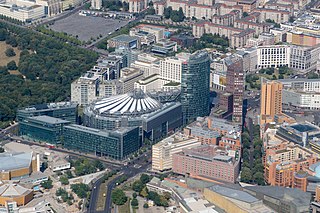
Potsdamer Platz is an important public square and traffic intersection in the center of Berlin, Germany, lying about 1 km (1,100 yd) south of the Brandenburg Gate and the Reichstag, and close to the southeast corner of the Tiergarten park. It is named after the city of Potsdam, some 25 km (16 mi) to the south west, and marks the point where the old road from Potsdam passed through the city wall of Berlin at the Potsdam Gate. After developing within the space of little over a century from an intersection of rural thoroughfares into the most bustling traffic intersection in Europe, it was totally destroyed during World War II and then left desolate during the Cold War era when the Berlin Wall bisected its former location. Since German reunification, Potsdamer Platz has been the site of major redevelopment projects.

Charlottenburg is a locality of Berlin within the borough of Charlottenburg-Wilmersdorf. Established as a town in 1705 and named after late Sophia Charlotte of Hanover, Queen consort of Prussia, it is best known for Charlottenburg Palace, the largest surviving royal palace in Berlin, and the adjacent museums.
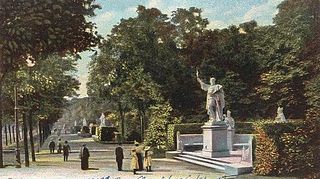
The Siegesallee was a broad boulevard in Berlin, Germany. In 1895, Kaiser Wilhelm II ordered and financed the expansion of an existing avenue, to be adorned with a variety of marble statues. Work was completed in 1901.
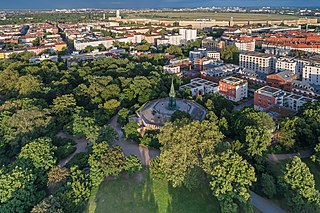
The Viktoriapark is an urban park in the locality of Kreuzberg in Berlin, Germany. It opened in 1894.

Bernhard Hans Henry Scharoun was a German architect best known for designing the Berliner Philharmonie and the Schminke House in Löbau, Saxony. He was an important exponent of organic and expressionist architecture.
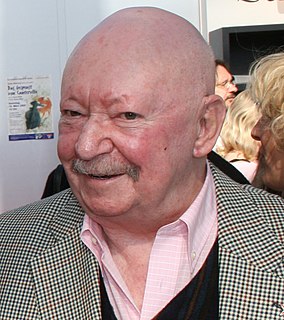
Günter Kunert was a German writer. Based in East Berlin, he published poetry from 1947, supported by Bertold Brecht. After he had signed a petition against the deprivation of the citizenship of Wolf Biermann in 1976, he lost his SED membership, and moved to the West two years later. He is regarded as a versatile German writer who wrote short stories, essays, autobiographical works, film scripts and novels. He received international honorary doctorates and awards.

Claire Waldoff, born Clara Wortmann, was a German singer. She was a famous kabarett singer and entertainer in Berlin during the 1910s and 1920s, chiefly known for performing ironic songs in the Berlin dialect and with lesbian undertones and themes.
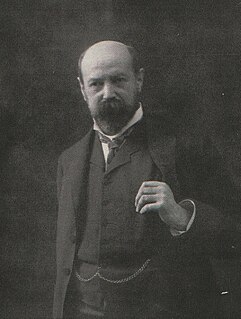
Alfred Messel was one of the most well-known German architect at the turning point to the 20th century, creating a new style for buildings which bridged the transition from historicism to modernism. Messel was able to combine the structure, decoration, and function of his buildings, which ranged from department stores, museums, office buildings, mansions, and social housing to soup kitchens, into a coherent, harmonious whole. As an urban architect striving for excellence he was in many respects ahead of his time. His most well known works, the Wertheim department stores and the Pergamon Museum in Berlin, reflect a new concept of self-confident metropolitan architecture. His architectural drawings and construction plans are preserved at the Architecture Museum of the Technical University of Berlin.

The Great Industrial Exposition of Berlin 1896 was a large exposition that has also been dubbed "the impeded world fair".
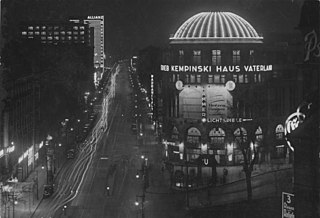
Haus Vaterland was a pleasure palace on the southwest side of Potsdamer Platz in central Berlin. Preceded by Haus Potsdam, a multi-use building including a large cinema and a huge cafe, from 1928 to 1943 it was a large, famous establishment including the largest cafe in the world, a major cinema, a large ballroom and numerous theme restaurants, promoted as a showcase of all nations. It was partially destroyed by fire in World War II, reopened in a limited form until 1953, and was finally demolished in 1976.
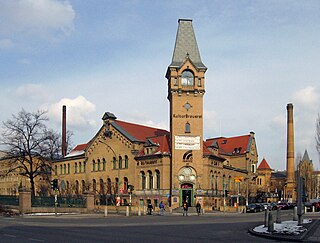
The Berlin Kulturbrauerei is a 25,000 square metres (270,000 sq ft) building complex in Berlin, Germany. Originally built and operated as a brewery, its courtyards and unique architecture have been protected as a monument since 1974 and it is one of the few well-preserved examples of industrial architecture in Berlin dating from the end of the 19th century.

The Theater des Westens is one of the most famous theatres for musicals and operettas in Berlin, Germany, located at Kantstraße 10–12 in Charlottenburg. It was founded in 1895 for plays. The present house was opened in 1896 and dedicated to opera and operetta. Enrico Caruso made his debut in Berlin here, and the Ballets Russes appeared with Anna Pavlova. In the 1930s it was run as the Volkstheater Berlin. After World War II it served as the temporary opera house of Berlin, the Städtische Oper. In 1961 it became the first theatre in Germany to show musicals. Since then it has become the "German equivalent of Broadway extravaganzas", putting on plays and musical comedies.

Berlin is recognized as a world city of culture and creative industries. Numerous cultural institutions, many of which enjoy international reputation are representing the diverse heritage of the city. Many young people, cultural entrepreneurs and international artists continue to settle in the city. Berlin has established itself as a popular entertainment center in Europe.
Ernst Stahl-Nachbaur was a German film actor.

Quasimodo is a music venue in the Charlottenburg district of Berlin. It is located on the corner of Kantstraße and Fasanenstraße in the basement of the building of the Delphi Filmpalast, a former dance hall and movie theater which is also home to the Quasimodo Café and the Vaganten Bühne theatre. The club offers accommodation for up to 350 seated guests. Rock, Latin music and world music are also presented in concerts along with its more traditional emphasis on modern jazz, blues, soul and funk. Its programme features renowned international artists as well as musicians from the local Berlin and national scene.
The following is a timeline of the history of the city of Berlin, Germany.

Kemperplatz is situated in the Tiergarten subdivision of the Mitte district in Berlin, Germany. It leads to Lennéstraße, Ben-Gurion-Straße, Tiergartenstraße, and connects to the Tiergarten Spreebogen Tunnel.

C/O Berlin is a gallery in Berlin, specialising in photography and other visual media. It is located in Amerika Haus Berlin, Charlottenburg, where it has more than 2,000 square metres of space. It was founded in 2000 by Stephan Erfurt, Marc Naroska and Ingo Pott and originally located in the old Royal Post Office (Postfuhramt).

Cuisine of Berlin describes different aspects of Berlin's culinary offerings. On the one hand, it means the traditional Berlin cuisine of Berlin households with dishes such as Königsberger Klopse or Kassler and, on the other hand, often a rustic pub and snack kitchen, which has become increasingly international due to labor migration since the Second World War. Since German reunification, numerous top-class restaurants have also been added.
Villa d'Este may be: